Comprehensive Analysis of Unemployment in the Australian Economy
VerifiedAdded on 2023/06/11
|7
|1534
|235
Report
AI Summary
This report provides a comprehensive analysis of unemployment in the Australian economy. It begins by outlining the methods used to measure unemployment in India, including the Usual Status Approach, Current Week Status Approach, and Daily Status Approach, as well as the Claimant Count and Labor Force Survey methods. The report then shifts its focus to Australia, examining the causes of unemployment such as industry shutdowns, decreased infrastructure spending, recessionary impacts, and immigration policies. It also discusses the variations in unemployment rates across different regions of Australia, highlighting Western Australia and the Northern Territory. Finally, the report reviews the monetary and fiscal policies implemented by the Australian government to combat unemployment, concluding with the need for labor law reforms and strategic investments in sectors like retail and infrastructure to create more employment opportunities. Desklib offers a wealth of similar reports and solved assignments for students.
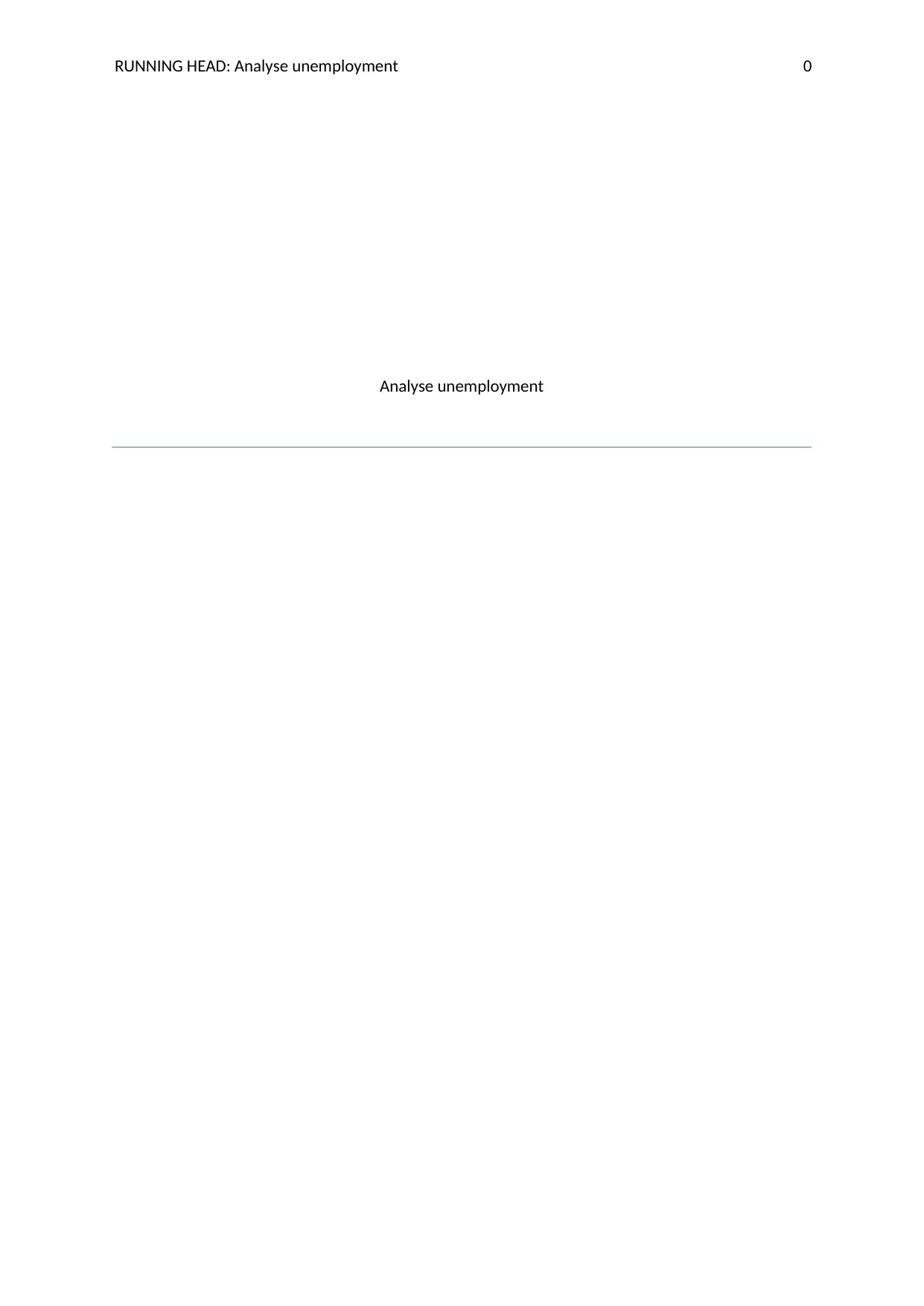
RUNNING HEAD: Analyse unemployment 0
Analyse unemployment
Analyse unemployment
Paraphrase This Document
Need a fresh take? Get an instant paraphrase of this document with our AI Paraphraser
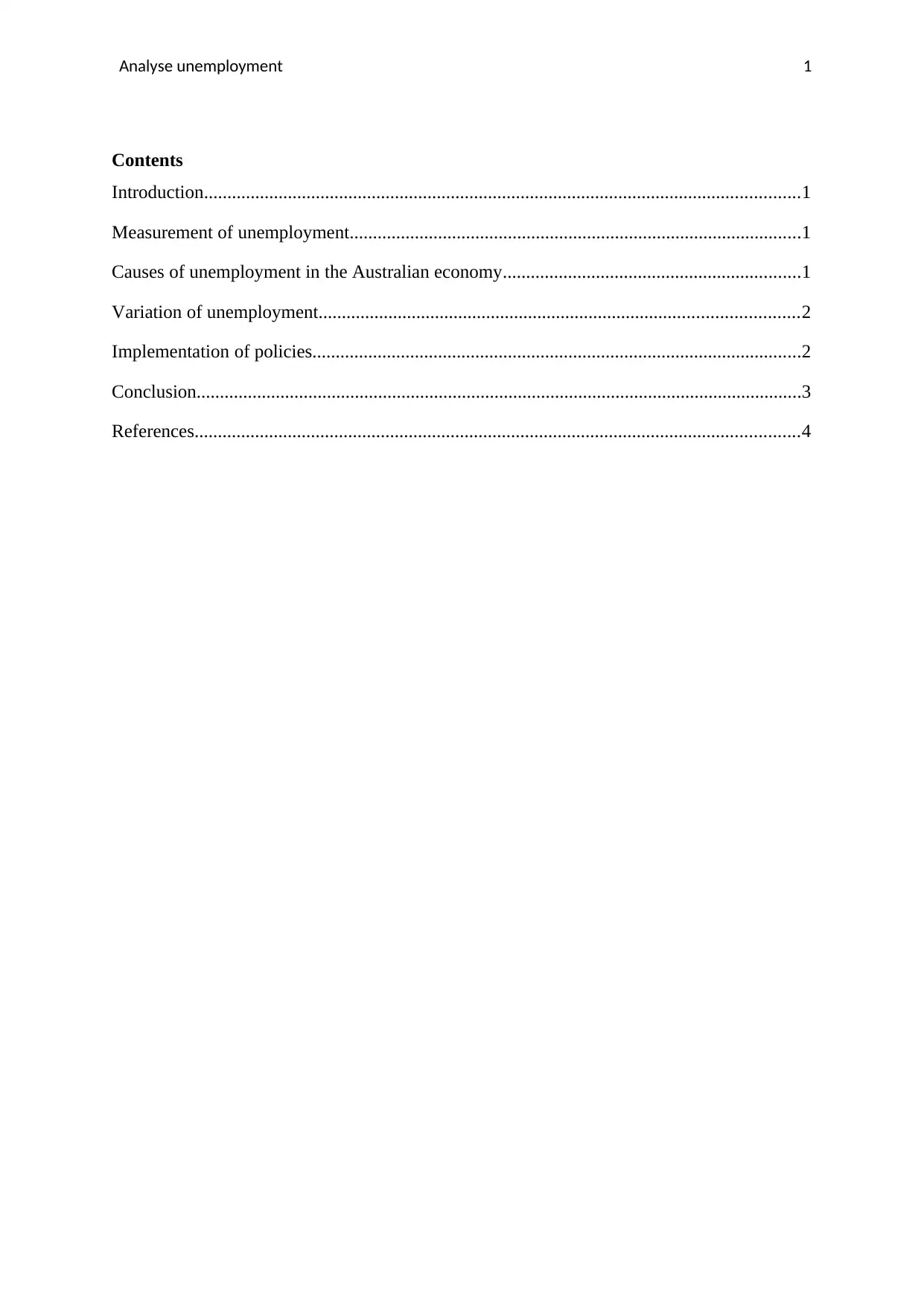
Analyse unemployment 1
Contents
Introduction................................................................................................................................1
Measurement of unemployment.................................................................................................1
Causes of unemployment in the Australian economy................................................................1
Variation of unemployment.......................................................................................................2
Implementation of policies.........................................................................................................2
Conclusion..................................................................................................................................3
References..................................................................................................................................4
Contents
Introduction................................................................................................................................1
Measurement of unemployment.................................................................................................1
Causes of unemployment in the Australian economy................................................................1
Variation of unemployment.......................................................................................................2
Implementation of policies.........................................................................................................2
Conclusion..................................................................................................................................3
References..................................................................................................................................4
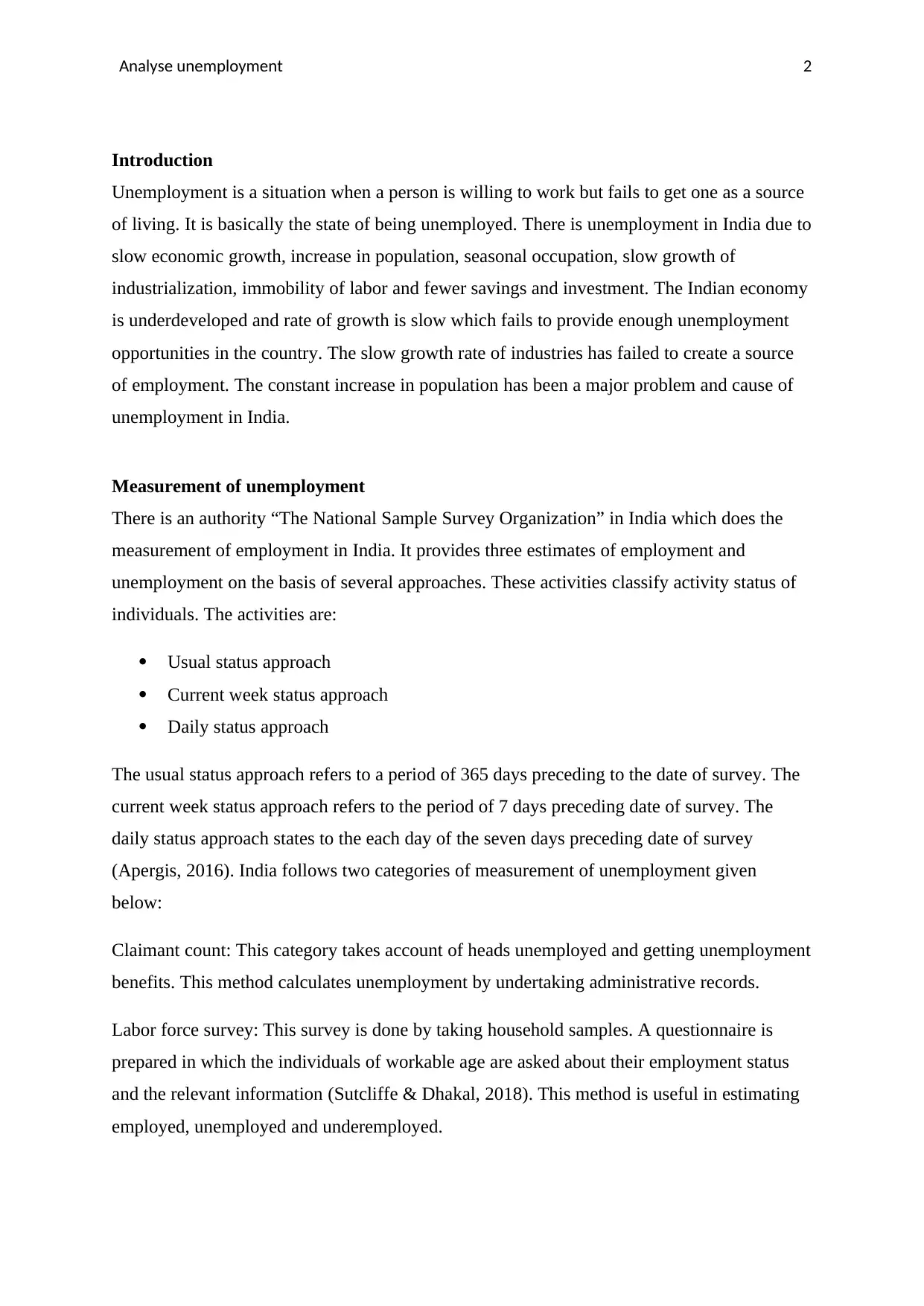
Analyse unemployment 2
Introduction
Unemployment is a situation when a person is willing to work but fails to get one as a source
of living. It is basically the state of being unemployed. There is unemployment in India due to
slow economic growth, increase in population, seasonal occupation, slow growth of
industrialization, immobility of labor and fewer savings and investment. The Indian economy
is underdeveloped and rate of growth is slow which fails to provide enough unemployment
opportunities in the country. The slow growth rate of industries has failed to create a source
of employment. The constant increase in population has been a major problem and cause of
unemployment in India.
Measurement of unemployment
There is an authority “The National Sample Survey Organization” in India which does the
measurement of employment in India. It provides three estimates of employment and
unemployment on the basis of several approaches. These activities classify activity status of
individuals. The activities are:
Usual status approach
Current week status approach
Daily status approach
The usual status approach refers to a period of 365 days preceding to the date of survey. The
current week status approach refers to the period of 7 days preceding date of survey. The
daily status approach states to the each day of the seven days preceding date of survey
(Apergis, 2016). India follows two categories of measurement of unemployment given
below:
Claimant count: This category takes account of heads unemployed and getting unemployment
benefits. This method calculates unemployment by undertaking administrative records.
Labor force survey: This survey is done by taking household samples. A questionnaire is
prepared in which the individuals of workable age are asked about their employment status
and the relevant information (Sutcliffe & Dhakal, 2018). This method is useful in estimating
employed, unemployed and underemployed.
Introduction
Unemployment is a situation when a person is willing to work but fails to get one as a source
of living. It is basically the state of being unemployed. There is unemployment in India due to
slow economic growth, increase in population, seasonal occupation, slow growth of
industrialization, immobility of labor and fewer savings and investment. The Indian economy
is underdeveloped and rate of growth is slow which fails to provide enough unemployment
opportunities in the country. The slow growth rate of industries has failed to create a source
of employment. The constant increase in population has been a major problem and cause of
unemployment in India.
Measurement of unemployment
There is an authority “The National Sample Survey Organization” in India which does the
measurement of employment in India. It provides three estimates of employment and
unemployment on the basis of several approaches. These activities classify activity status of
individuals. The activities are:
Usual status approach
Current week status approach
Daily status approach
The usual status approach refers to a period of 365 days preceding to the date of survey. The
current week status approach refers to the period of 7 days preceding date of survey. The
daily status approach states to the each day of the seven days preceding date of survey
(Apergis, 2016). India follows two categories of measurement of unemployment given
below:
Claimant count: This category takes account of heads unemployed and getting unemployment
benefits. This method calculates unemployment by undertaking administrative records.
Labor force survey: This survey is done by taking household samples. A questionnaire is
prepared in which the individuals of workable age are asked about their employment status
and the relevant information (Sutcliffe & Dhakal, 2018). This method is useful in estimating
employed, unemployed and underemployed.
⊘ This is a preview!⊘
Do you want full access?
Subscribe today to unlock all pages.

Trusted by 1+ million students worldwide
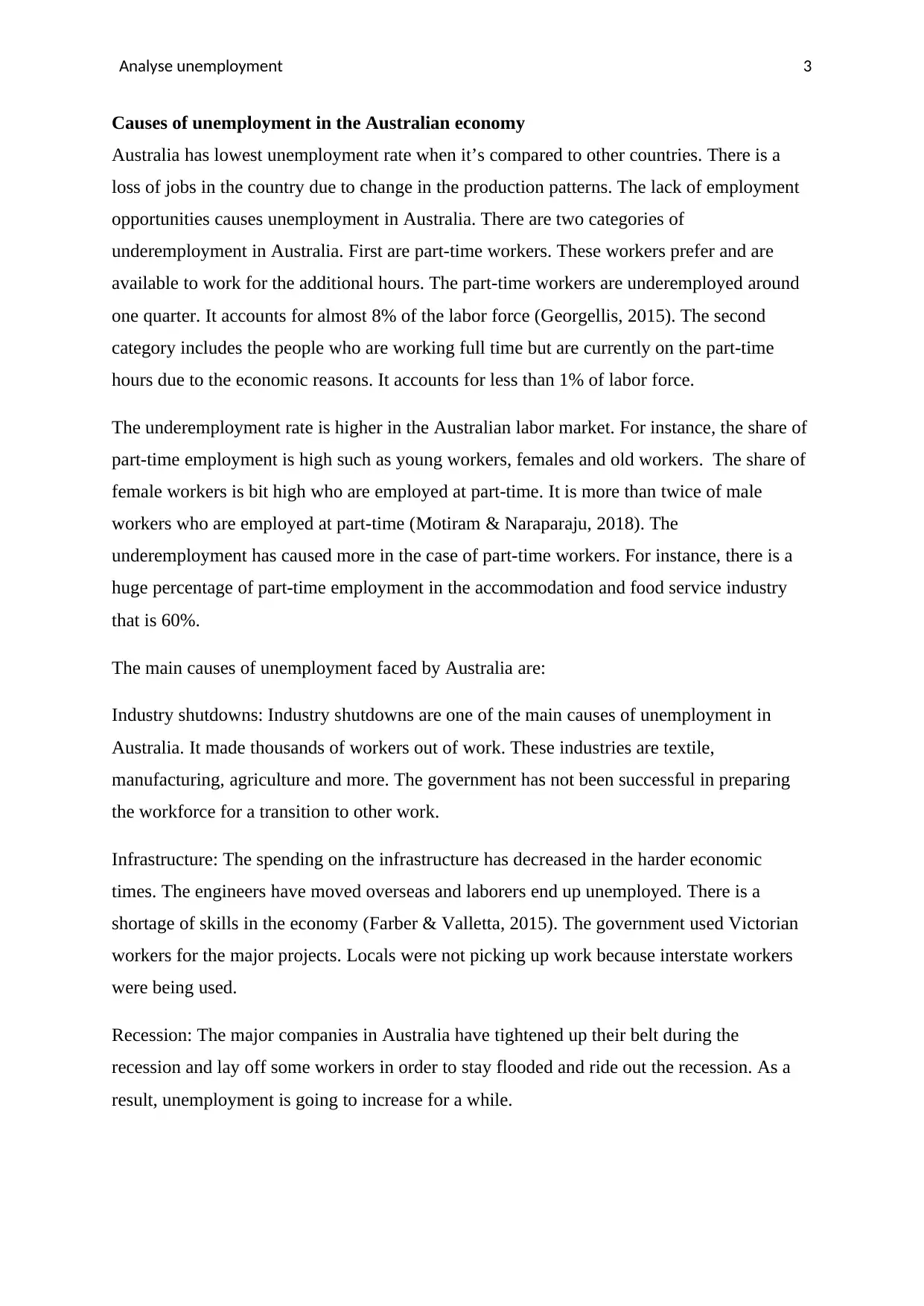
Analyse unemployment 3
Causes of unemployment in the Australian economy
Australia has lowest unemployment rate when it’s compared to other countries. There is a
loss of jobs in the country due to change in the production patterns. The lack of employment
opportunities causes unemployment in Australia. There are two categories of
underemployment in Australia. First are part-time workers. These workers prefer and are
available to work for the additional hours. The part-time workers are underemployed around
one quarter. It accounts for almost 8% of the labor force (Georgellis, 2015). The second
category includes the people who are working full time but are currently on the part-time
hours due to the economic reasons. It accounts for less than 1% of labor force.
The underemployment rate is higher in the Australian labor market. For instance, the share of
part-time employment is high such as young workers, females and old workers. The share of
female workers is bit high who are employed at part-time. It is more than twice of male
workers who are employed at part-time (Motiram & Naraparaju, 2018). The
underemployment has caused more in the case of part-time workers. For instance, there is a
huge percentage of part-time employment in the accommodation and food service industry
that is 60%.
The main causes of unemployment faced by Australia are:
Industry shutdowns: Industry shutdowns are one of the main causes of unemployment in
Australia. It made thousands of workers out of work. These industries are textile,
manufacturing, agriculture and more. The government has not been successful in preparing
the workforce for a transition to other work.
Infrastructure: The spending on the infrastructure has decreased in the harder economic
times. The engineers have moved overseas and laborers end up unemployed. There is a
shortage of skills in the economy (Farber & Valletta, 2015). The government used Victorian
workers for the major projects. Locals were not picking up work because interstate workers
were being used.
Recession: The major companies in Australia have tightened up their belt during the
recession and lay off some workers in order to stay flooded and ride out the recession. As a
result, unemployment is going to increase for a while.
Causes of unemployment in the Australian economy
Australia has lowest unemployment rate when it’s compared to other countries. There is a
loss of jobs in the country due to change in the production patterns. The lack of employment
opportunities causes unemployment in Australia. There are two categories of
underemployment in Australia. First are part-time workers. These workers prefer and are
available to work for the additional hours. The part-time workers are underemployed around
one quarter. It accounts for almost 8% of the labor force (Georgellis, 2015). The second
category includes the people who are working full time but are currently on the part-time
hours due to the economic reasons. It accounts for less than 1% of labor force.
The underemployment rate is higher in the Australian labor market. For instance, the share of
part-time employment is high such as young workers, females and old workers. The share of
female workers is bit high who are employed at part-time. It is more than twice of male
workers who are employed at part-time (Motiram & Naraparaju, 2018). The
underemployment has caused more in the case of part-time workers. For instance, there is a
huge percentage of part-time employment in the accommodation and food service industry
that is 60%.
The main causes of unemployment faced by Australia are:
Industry shutdowns: Industry shutdowns are one of the main causes of unemployment in
Australia. It made thousands of workers out of work. These industries are textile,
manufacturing, agriculture and more. The government has not been successful in preparing
the workforce for a transition to other work.
Infrastructure: The spending on the infrastructure has decreased in the harder economic
times. The engineers have moved overseas and laborers end up unemployed. There is a
shortage of skills in the economy (Farber & Valletta, 2015). The government used Victorian
workers for the major projects. Locals were not picking up work because interstate workers
were being used.
Recession: The major companies in Australia have tightened up their belt during the
recession and lay off some workers in order to stay flooded and ride out the recession. As a
result, unemployment is going to increase for a while.
Paraphrase This Document
Need a fresh take? Get an instant paraphrase of this document with our AI Paraphraser
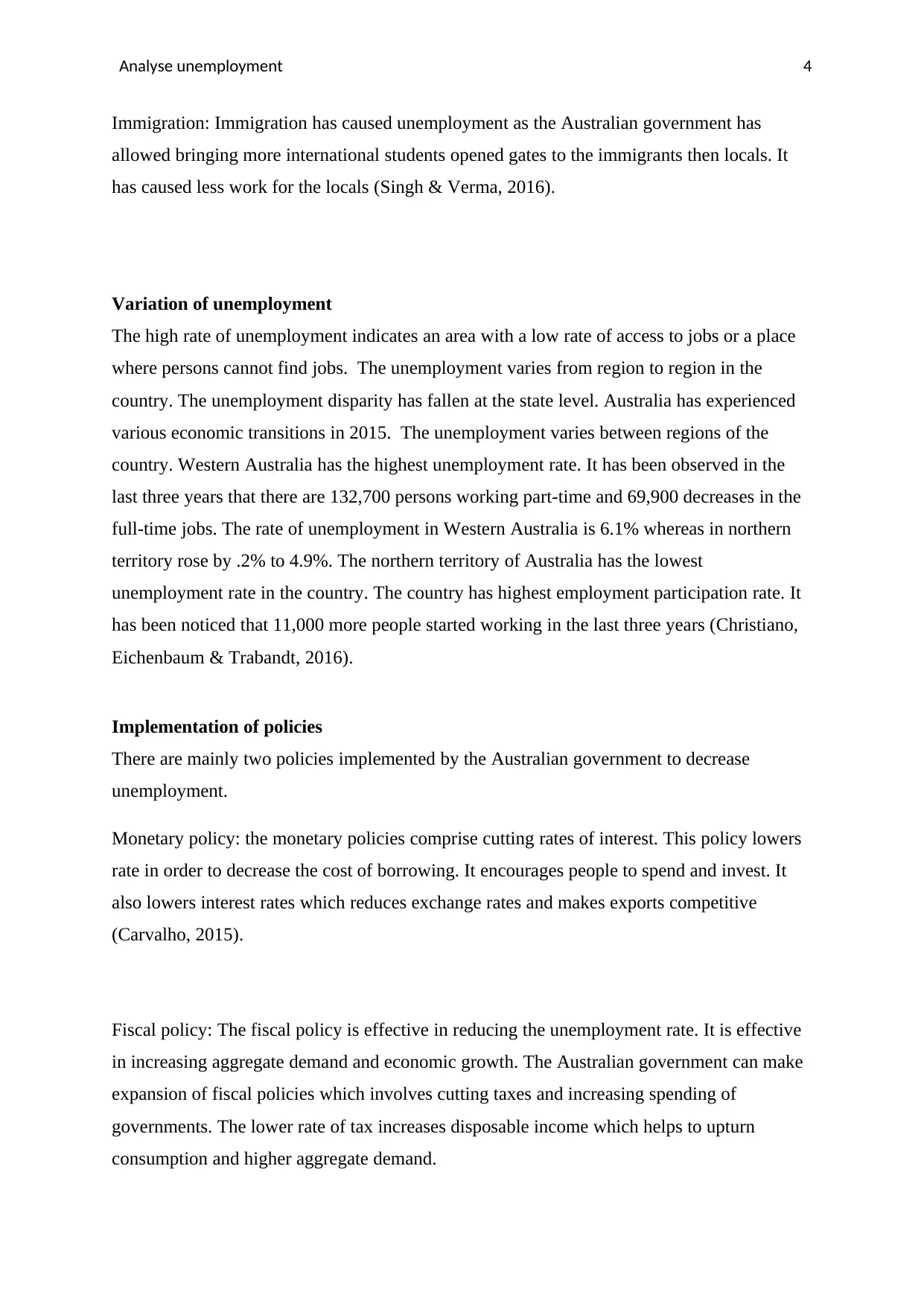
Analyse unemployment 4
Immigration: Immigration has caused unemployment as the Australian government has
allowed bringing more international students opened gates to the immigrants then locals. It
has caused less work for the locals (Singh & Verma, 2016).
Variation of unemployment
The high rate of unemployment indicates an area with a low rate of access to jobs or a place
where persons cannot find jobs. The unemployment varies from region to region in the
country. The unemployment disparity has fallen at the state level. Australia has experienced
various economic transitions in 2015. The unemployment varies between regions of the
country. Western Australia has the highest unemployment rate. It has been observed in the
last three years that there are 132,700 persons working part-time and 69,900 decreases in the
full-time jobs. The rate of unemployment in Western Australia is 6.1% whereas in northern
territory rose by .2% to 4.9%. The northern territory of Australia has the lowest
unemployment rate in the country. The country has highest employment participation rate. It
has been noticed that 11,000 more people started working in the last three years (Christiano,
Eichenbaum & Trabandt, 2016).
Implementation of policies
There are mainly two policies implemented by the Australian government to decrease
unemployment.
Monetary policy: the monetary policies comprise cutting rates of interest. This policy lowers
rate in order to decrease the cost of borrowing. It encourages people to spend and invest. It
also lowers interest rates which reduces exchange rates and makes exports competitive
(Carvalho, 2015).
Fiscal policy: The fiscal policy is effective in reducing the unemployment rate. It is effective
in increasing aggregate demand and economic growth. The Australian government can make
expansion of fiscal policies which involves cutting taxes and increasing spending of
governments. The lower rate of tax increases disposable income which helps to upturn
consumption and higher aggregate demand.
Immigration: Immigration has caused unemployment as the Australian government has
allowed bringing more international students opened gates to the immigrants then locals. It
has caused less work for the locals (Singh & Verma, 2016).
Variation of unemployment
The high rate of unemployment indicates an area with a low rate of access to jobs or a place
where persons cannot find jobs. The unemployment varies from region to region in the
country. The unemployment disparity has fallen at the state level. Australia has experienced
various economic transitions in 2015. The unemployment varies between regions of the
country. Western Australia has the highest unemployment rate. It has been observed in the
last three years that there are 132,700 persons working part-time and 69,900 decreases in the
full-time jobs. The rate of unemployment in Western Australia is 6.1% whereas in northern
territory rose by .2% to 4.9%. The northern territory of Australia has the lowest
unemployment rate in the country. The country has highest employment participation rate. It
has been noticed that 11,000 more people started working in the last three years (Christiano,
Eichenbaum & Trabandt, 2016).
Implementation of policies
There are mainly two policies implemented by the Australian government to decrease
unemployment.
Monetary policy: the monetary policies comprise cutting rates of interest. This policy lowers
rate in order to decrease the cost of borrowing. It encourages people to spend and invest. It
also lowers interest rates which reduces exchange rates and makes exports competitive
(Carvalho, 2015).
Fiscal policy: The fiscal policy is effective in reducing the unemployment rate. It is effective
in increasing aggregate demand and economic growth. The Australian government can make
expansion of fiscal policies which involves cutting taxes and increasing spending of
governments. The lower rate of tax increases disposable income which helps to upturn
consumption and higher aggregate demand.
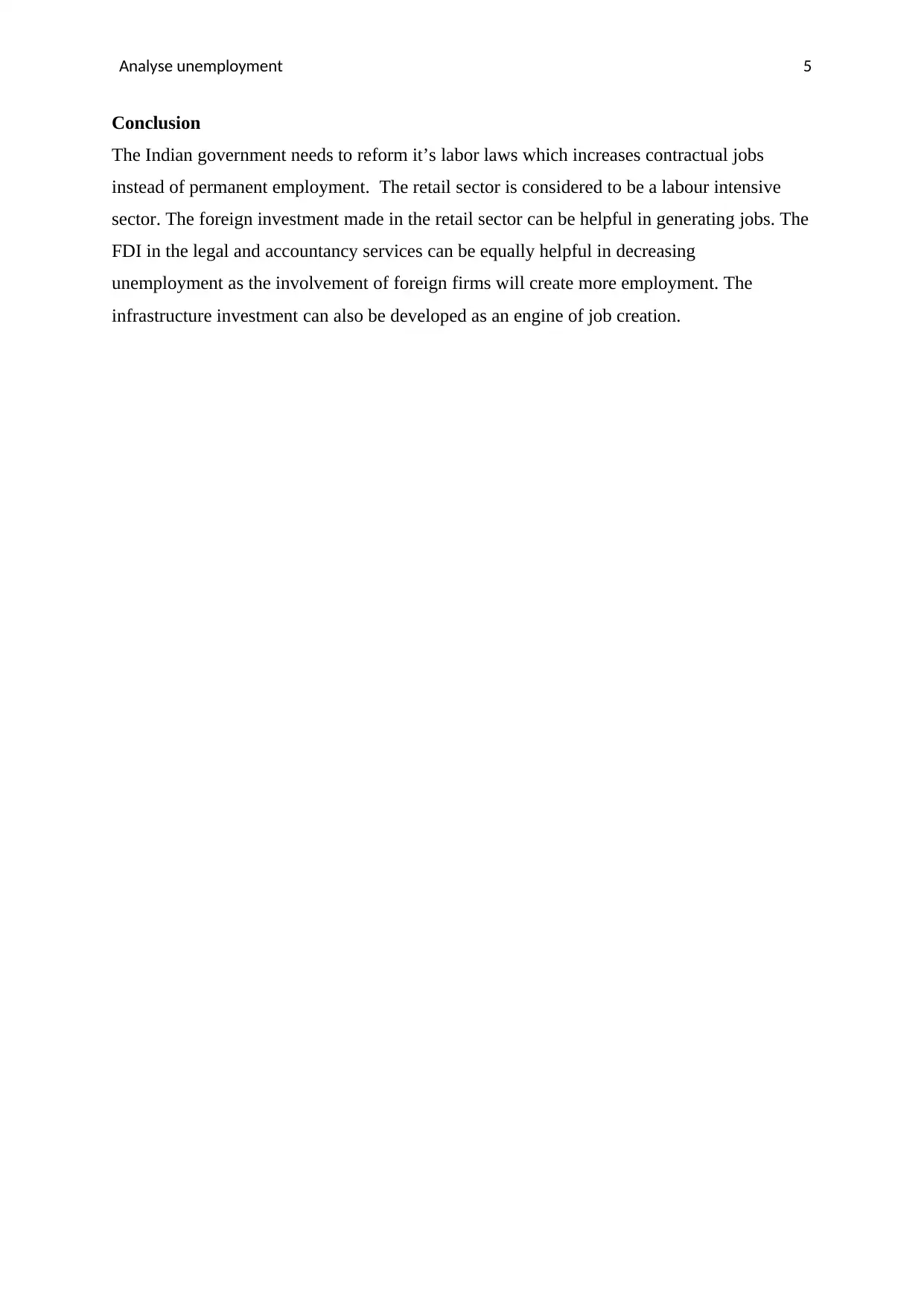
Analyse unemployment 5
Conclusion
The Indian government needs to reform it’s labor laws which increases contractual jobs
instead of permanent employment. The retail sector is considered to be a labour intensive
sector. The foreign investment made in the retail sector can be helpful in generating jobs. The
FDI in the legal and accountancy services can be equally helpful in decreasing
unemployment as the involvement of foreign firms will create more employment. The
infrastructure investment can also be developed as an engine of job creation.
Conclusion
The Indian government needs to reform it’s labor laws which increases contractual jobs
instead of permanent employment. The retail sector is considered to be a labour intensive
sector. The foreign investment made in the retail sector can be helpful in generating jobs. The
FDI in the legal and accountancy services can be equally helpful in decreasing
unemployment as the involvement of foreign firms will create more employment. The
infrastructure investment can also be developed as an engine of job creation.
⊘ This is a preview!⊘
Do you want full access?
Subscribe today to unlock all pages.

Trusted by 1+ million students worldwide
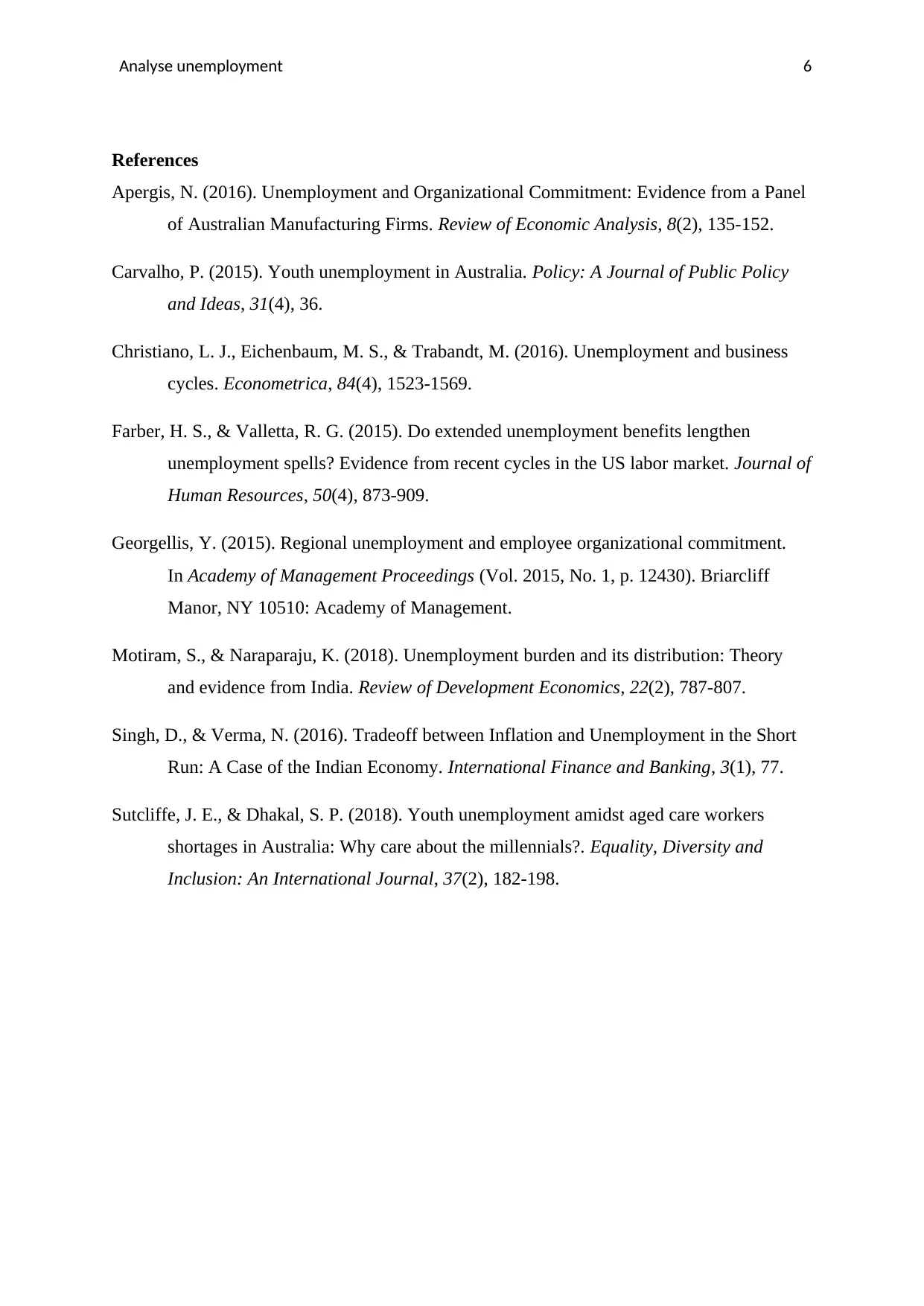
Analyse unemployment 6
References
Apergis, N. (2016). Unemployment and Organizational Commitment: Evidence from a Panel
of Australian Manufacturing Firms. Review of Economic Analysis, 8(2), 135-152.
Carvalho, P. (2015). Youth unemployment in Australia. Policy: A Journal of Public Policy
and Ideas, 31(4), 36.
Christiano, L. J., Eichenbaum, M. S., & Trabandt, M. (2016). Unemployment and business
cycles. Econometrica, 84(4), 1523-1569.
Farber, H. S., & Valletta, R. G. (2015). Do extended unemployment benefits lengthen
unemployment spells? Evidence from recent cycles in the US labor market. Journal of
Human Resources, 50(4), 873-909.
Georgellis, Y. (2015). Regional unemployment and employee organizational commitment.
In Academy of Management Proceedings (Vol. 2015, No. 1, p. 12430). Briarcliff
Manor, NY 10510: Academy of Management.
Motiram, S., & Naraparaju, K. (2018). Unemployment burden and its distribution: Theory
and evidence from India. Review of Development Economics, 22(2), 787-807.
Singh, D., & Verma, N. (2016). Tradeoff between Inflation and Unemployment in the Short
Run: A Case of the Indian Economy. International Finance and Banking, 3(1), 77.
Sutcliffe, J. E., & Dhakal, S. P. (2018). Youth unemployment amidst aged care workers
shortages in Australia: Why care about the millennials?. Equality, Diversity and
Inclusion: An International Journal, 37(2), 182-198.
References
Apergis, N. (2016). Unemployment and Organizational Commitment: Evidence from a Panel
of Australian Manufacturing Firms. Review of Economic Analysis, 8(2), 135-152.
Carvalho, P. (2015). Youth unemployment in Australia. Policy: A Journal of Public Policy
and Ideas, 31(4), 36.
Christiano, L. J., Eichenbaum, M. S., & Trabandt, M. (2016). Unemployment and business
cycles. Econometrica, 84(4), 1523-1569.
Farber, H. S., & Valletta, R. G. (2015). Do extended unemployment benefits lengthen
unemployment spells? Evidence from recent cycles in the US labor market. Journal of
Human Resources, 50(4), 873-909.
Georgellis, Y. (2015). Regional unemployment and employee organizational commitment.
In Academy of Management Proceedings (Vol. 2015, No. 1, p. 12430). Briarcliff
Manor, NY 10510: Academy of Management.
Motiram, S., & Naraparaju, K. (2018). Unemployment burden and its distribution: Theory
and evidence from India. Review of Development Economics, 22(2), 787-807.
Singh, D., & Verma, N. (2016). Tradeoff between Inflation and Unemployment in the Short
Run: A Case of the Indian Economy. International Finance and Banking, 3(1), 77.
Sutcliffe, J. E., & Dhakal, S. P. (2018). Youth unemployment amidst aged care workers
shortages in Australia: Why care about the millennials?. Equality, Diversity and
Inclusion: An International Journal, 37(2), 182-198.
1 out of 7
Related Documents
Your All-in-One AI-Powered Toolkit for Academic Success.
+13062052269
info@desklib.com
Available 24*7 on WhatsApp / Email
![[object Object]](/_next/static/media/star-bottom.7253800d.svg)
Unlock your academic potential
Copyright © 2020–2025 A2Z Services. All Rights Reserved. Developed and managed by ZUCOL.





